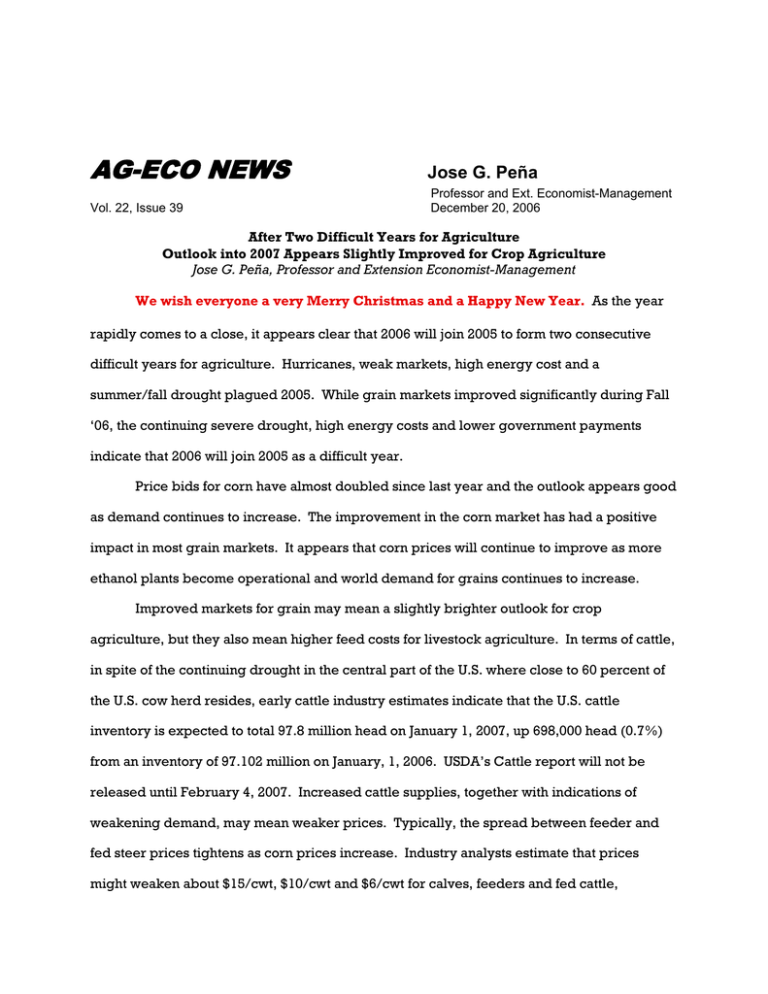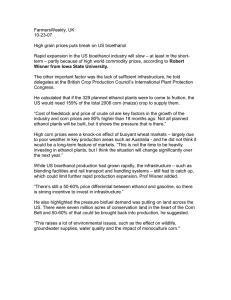AG-ECO NEWS Jose G. Peña
advertisement

AG-ECO NEWS Jose G. Peña Vol. 22, Issue 39 Professor and Ext. Economist-Management December 20, 2006 After Two Difficult Years for Agriculture Outlook into 2007 Appears Slightly Improved for Crop Agriculture Jose G. Peña, Professor and Extension Economist-Management We wish everyone a very Merry Christmas and a Happy New Year. As the year rapidly comes to a close, it appears clear that 2006 will join 2005 to form two consecutive difficult years for agriculture. Hurricanes, weak markets, high energy cost and a summer/fall drought plagued 2005. While grain markets improved significantly during Fall ‘06, the continuing severe drought, high energy costs and lower government payments indicate that 2006 will join 2005 as a difficult year. Price bids for corn have almost doubled since last year and the outlook appears good as demand continues to increase. The improvement in the corn market has had a positive impact in most grain markets. It appears that corn prices will continue to improve as more ethanol plants become operational and world demand for grains continues to increase. Improved markets for grain may mean a slightly brighter outlook for crop agriculture, but they also mean higher feed costs for livestock agriculture. In terms of cattle, in spite of the continuing drought in the central part of the U.S. where close to 60 percent of the U.S. cow herd resides, early cattle industry estimates indicate that the U.S. cattle inventory is expected to total 97.8 million head on January 1, 2007, up 698,000 head (0.7%) from an inventory of 97.102 million on January, 1, 2006. USDA’s Cattle report will not be released until February 4, 2007. Increased cattle supplies, together with indications of weakening demand, may mean weaker prices. Typically, the spread between feeder and fed steer prices tightens as corn prices increase. Industry analysts estimate that prices might weaken about $15/cwt, $10/cwt and $6/cwt for calves, feeders and fed cattle, respectively. Corn It appears that increased demand and tight supplies are fueling the corn market. Even with the last three years of record corn crops, USDA’s December 11, 2006 estimate of U.S. corn production at 10.745 billion bushels will be the second consecutive year in which corn production has declined. U.S. corn disappearance has outstripped production during five of the past six Figure 1: U.S. Corn Production and Total Use 13.00 Billion Bushels Total Use Production 11.11 10.23 10.00 9.00 expected to reach a record large 8.00 11.79 billion bushels in 2006/07, 7.00 11.79 11.26 11.00 years. (See Figure 1). Total use is more than one billion bushels larger 11.81 12.00 9.92 9.52 9.82 10.75 10.66 10.09 9.49 9.74 9.51 9.43 8.97 1999 2000 2001 2002 2003 2004 2005 2006 Source: World Agricultural Supply and Demand Estimates (WASDE) than current production, with the bulk of the increased demand attributable to increased ethanol production. The current estimate for ethanol use at 2.15 billion bushels is up 34% from last year and now accounts for about 20% of this season’s entire U.S. corn crop. As a result, it appears that the demand curve for corn has shifted to the right and we can expect to sustain the recent market improvement for the next few seasons. But, since ethanol use is one of the principal factors driving the market, increased demand can only be sustained if crude oil prices remain in the $60/barrel range or above. If prices drop significantly below this level, it may be difficult for ethanol to remain competitive without substantially increased subsidies. What’s Ahead ! Farm Bill 2007 negotiations will resume early next year but farm bill passage may be delayed into 2008 as drafting legislation that complies with World Trade Organization (WTO) rules will be difficult to negotiate. It is likely that crop program payments will be cut and that the new bill will include new provisions such as for environmental protection, rural development, research, new product development and to open markets. ! Increased acreage planted to corn to capture recent market improvements from increased demand. ! More food safety regulations with trace back audit trails, will probably be implemented as a result of this past fall’s crisis with E-Coli contaminated food products. ! Increased demand for organic products, especially after this past fall’s crisis with EColi contaminated food products. ! Increased use of source and processed verified livestock. ! Increased use of Genetically Modified Organisms (GMOs) as producers attempt to reduce energy/labor intensive production costs. This will continue to cause problems with importing nations. ! Passage of immigration reform legislation which allows a guest worker program, including provisions for day labor. ! Increased reliance on technology and market linkages. For example, traditional open bid commodity markets for animals are fading in importance and most animals are marketed through contracts, cooperatives and a variety of arrangements that link production with processing and retailing of final products.





